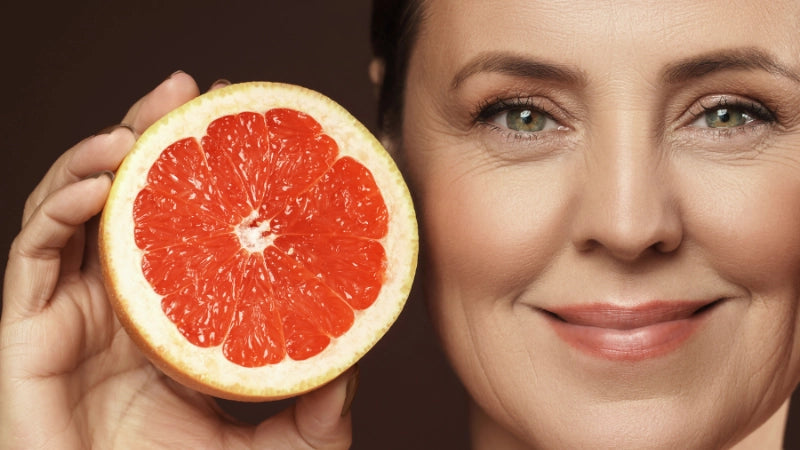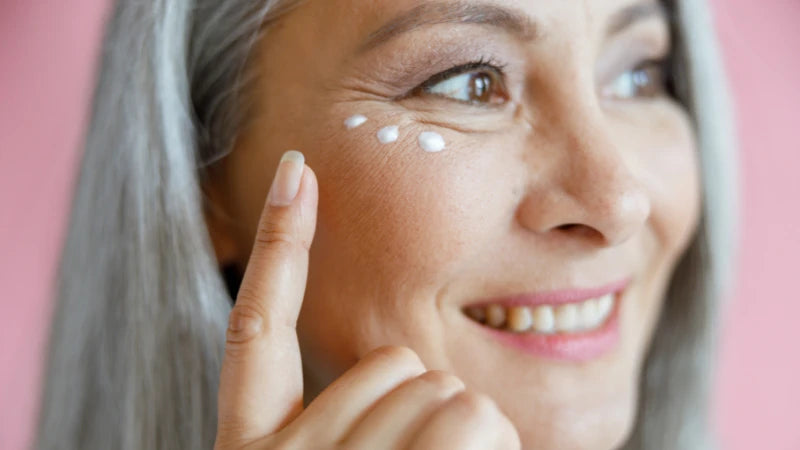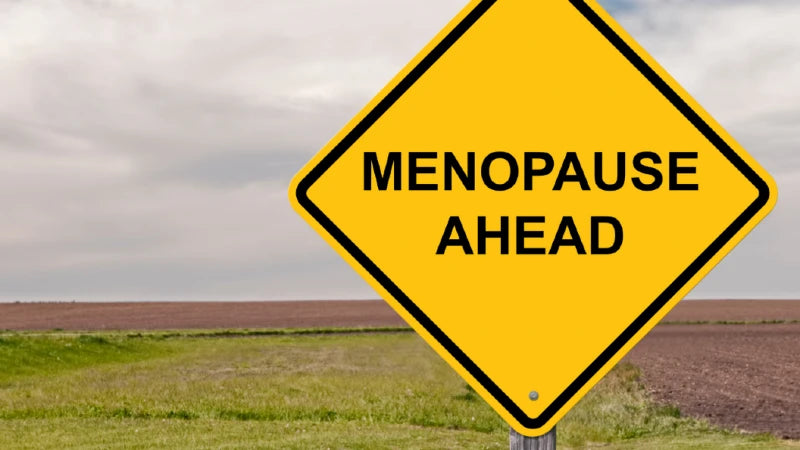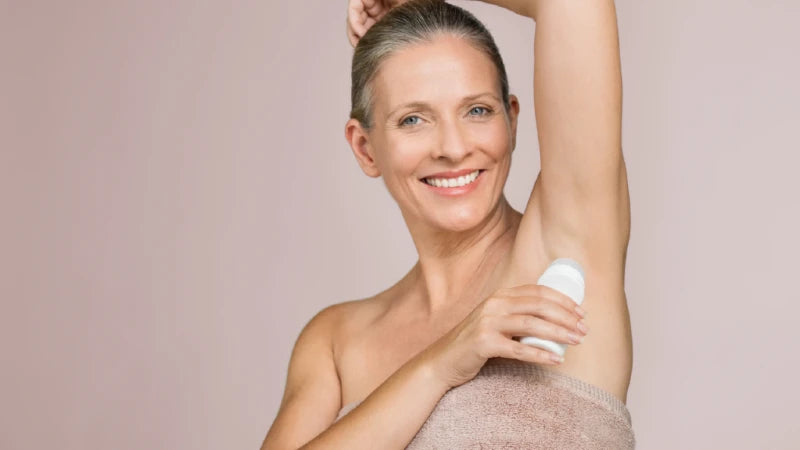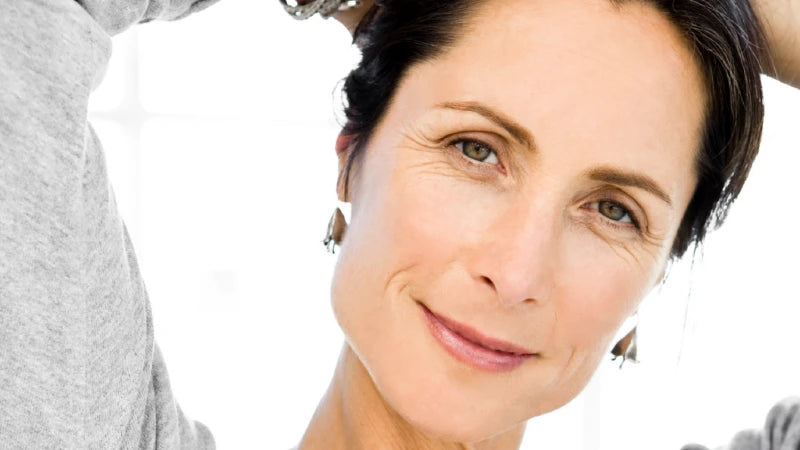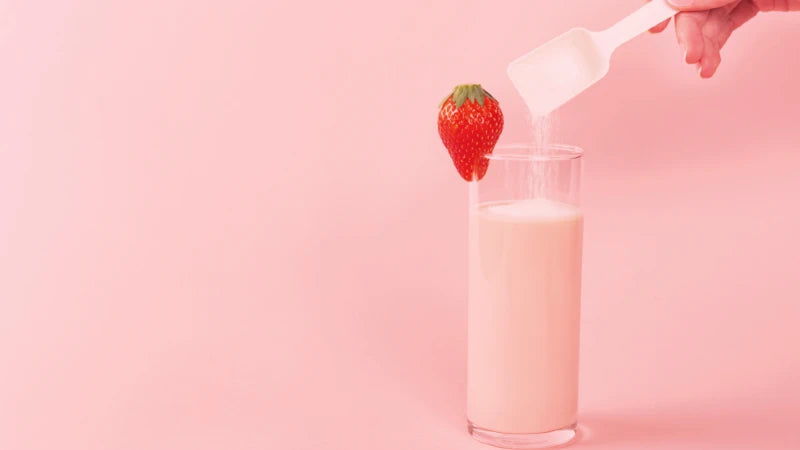Blog
9 Vitamin C Myths You Must Stop Believing
Although it’s a superstar skin care ingredient, there are many vitamin C myths circulating around when it comes to skin care. We’ve written about its benefits before, and in this post, we’re debunking the 9 most common vitamin C myths and setting the record straight. Shop Bespoke Vitamin C 15% Shop Bespoke Vitamin C 10% 1. All vitamin C is the same While the front of your bottle may read as just simply containing vitamin C, in the ingredient list, it can show up as L-ascorbic Acid (pure vitamin C) or other forms including ascorbyl glucoside, magnesium ascorbyl phosphate, ascorbyl tetraisopalmitate, etc. While they are all called vitamin C, they differ in the results they deliver. Plus, each type may be tolerated differently when it comes to your skin. So what type of vitamin C is best? We’re big fans of L-ascorbic acid, because it’s backed by the most amount of research when it comes to its benefits for skin–boosting collagen production; inhibiting melanin synthesis, which contributes to age spots; exfoliating for more glowing skin, etc. It’s what’s in our Glow Getter 15% and 10% Serums. However, if your skin is really sensitive, you may not be able to tolerate L-ascorbic acid, in which case you can look for a formulation made with a different vitamin C derivative. 2. Does vitamin C make your skin sensitive? No, it doesn’t. Vitamin C is acidic, which is why this myth may have gained traction. Vitamin C hasn’t been shown to increase sensitivity to the sun. In fact, studies show that this powerful antioxidant ingredient helps protect against free radical damage from the sun, boosting the protection you get from sunscreen. So, you can apply your vitamin C product in the a.m. or p.m. (or both), depending on what benefits you’re seeking and how it feels in your routine. Daytime application delivers antioxidative benefits, while nighttime application helps more with firming and rejuvenation–though you will also get some of these benefits with daytime application as well. 3. Vitamin C can replace your sunscreen While it’s true that vitamin C helps to protect against the sun’s ultraviolet rays, it is not—and should not be used as—a sunscreen. Vitamin C is one of the strongest defenders against free radicals– unstable molecules that damage skin–and which are caused by exposure to sunlight, pollution and smoke. Think of sunscreen as your first line of defense, helping to block damaging rays, with vitamin C as its assistant, helping to protect against free radicals that make it through the sunscreen’s protection. 4. You can become resistant to it This myth tends to circulate about many skin care ingredients; not just vitamin C. First, it’s important to understand that resistance happens when the number of receptors decrease. Since vitamin C is not active at any specific receptor in the skin, resistance can’t occur. Think of it another way. Vitamin C is not only good for your skin, it’s good for your overall health. If you’re eating nourishing foods every day, chances are that they are high in vitamin C and your body definitely isn’t becoming resistant to the benefits of the strawberries or kale salad that you’re eating on the daily. If a vitamin C formula is working for you, there’s no need to worry that it’s going to stop working. 5. Higher concentrations are always better When it comes to vitamin c myths, this may be the most common one! However, with skin care products, more isn’t necessarily better, because your skin can only absorb so much. Plus, because vitamin C is acidic, higher concentrations can end up being quite irritating. In fact, studies have shown that concentrations of L-ascorbic acid greater than 20% can actually be damaging to skin. As long as you are using a vitamin C treatment from a reputable company, you can feel confident that they’re following guidelines for skin care ingredients that have been established in clinical studies. Whether it’s 0.5%, 1% or 10% doesn’t matter–what matters is that the amount used has been researched to deliver results, without harming skin. 6. Vitamin C can’t be used by sensitive skin Vitamin C can be suitable for all skin types. Is vitamin C ok for sensitive skin? The trick is to find the right type of vitamin C for you. For example, while L-ascorbic acid is the most widely researched–and potent–form of vitamin C, it can also be irritating to sensitive skin. If that’s the case, you can opt for a lower concentration or use it less frequently. If that doesn’t work, then try a form that isn’t so acidic. There are many to choose from, including tetrahexyldecyl ascorbate, magnesium ascorbyl phosphate and ascorbyl glucoside. 7. Vitamin C can’t be combined with other acids, retinol, or niacinamide When it comes to vitamin C and niacinamide, there’s an outdated study that shows the two can potentially react to form nicotinic acid, which can cause skin irritation. However, this potential exists only when pure ascorbic acid and niacinamide are combined together at very high temperatures. Thankfully, it’s not something we need to worry about when it comes to skin care. In fact, pairing these two ingredients can be a winning combination, especially for tackling hyperpigmentation because the two work in different ways to combat discoloration: vitamin C inhibits the production of the pigment responsible for age spots, while niacinamide helps prevent the transfer of the overproduced pigmentation within cells. What about combined with acids or retinol? Vitamin C can be used with retinol, but there is a risk of skin irritation when they are used together. If you want to include both in your skin care routine, we recommend spreading out your actives between your morning and night routine or even between days or weeks. ie vitamin C in the morning and retinoid at night. Can you use vitamin C and AHA (or other acids) together? As with retinoids, your skin can become irritated with these two ingredients are combined. Space them out (morning/night) or alternate the days that you use one or the other. 8. Vitamin C can discolor your skin Vitamin C actually does the opposite! It inhibits the production of tyrosinase, an enzyme that is involved in the production of melanin, the pigment that gives skin its coloring—and which is associated with age spots and hyperpigmentation. The end result is brighter and more evenly toned skin; not discolored skin. 9. DIY vitamin C is a good idea While it’s possible to mix up your own vitamin c serum at home, there are a couple of things to be mindful of: Foods high in vitamin C, like lemon and other citrus juices can lead to phytophotodermatitis, a painful reaction, that can cause skin to blister and break out in drak patches. Don’t do this at home, no matter how many internet searches tell you it’s safe and effective. If you mix your own vitamin C serum, be sure to mix it fresh every day. Vitamin C oxidizes very quickly resulting in a product that may not only be ineffective, but also harmful. Plus, water-based products need preservatives to ensure they don’t become contaminated with baceteria, mold or fungus. Even if refrigerated, they won’t stay fresh for long. We like to think that this is one thing best left to the experts. Did we cover all the vitamin C myths you may have questions about? Let us know in the comments so we can get to more myth busting for you.
Learn moreHow To Fix Menopause Dryness With These Proven Solutions
The bad news—menopause dryness is an inevitable change for women as they age. The main reason for this is due to a drop in hormone levels, primarily estrogen, which leads to some noticeable changes to your skin and hair. The good news? Menopause dryness in all your body’s places is manageable and we’ve got you covered. Read on for all the ways to help turn your skin around. More Than Lip Service is a vaginal and vulvar moisturizer that alleviates the symptoms of dryness down there that occurs in more than 50% of women. Shop Intimate Care Feminine Moisturizer Does Menopause Dryness Go Away? Sadly, the hormonal changes that occur at menopause are permanent. During the lead-up to menopause—perimenopause—and at menopause, your body makes less estrogen, the hormone responsible for maintaining the elasticity, thickness, and suppleness of your skin. And while you may notice drier skin and hair, less obvious places on your whole body, including your neck, back, and chest, to elbows, legs, genitals — even nails, may be affected too. The inside of your mouth, nose, and eyes get drier as you age, as well. You might not think of them as skin, but just like the tissues inside your genitals–they’re called “mucosa,”–hormonal changes impact these as well, leaving you with itchy eye pain, cotton mouth, and that awful sandy feeling in your vagina. Thankfully there are many ways to help you, and your skin, feel better again. What Helps with Dry Skin During Menopause We’ve written about treating dry skin before and many of the tips outlined in these posts and our free guide, can help: Here’s How to Treat Dry Skin as You Get Older Make This One Change to Relieve Dry Skin Make This One Change to Relieve Dry Skin 5 Tips to Help You Care for Your Menopause Skin And you can also download our free guide packed with 7 Powerful—and easy—Tips to Help Banish Dry Skin. Why Am I Dry Down There All of a Sudden? Beyond your skin, hair and nails, you may notice menopause dryness in some unexpected places. Like down there. Estrogen’s impact on your skin also extends to the mucosal tissue found in your vulva and vagina. Low levels of the hormone can lead to thinning, drying, and inflammation of the vaginal walls. Vaginal tissues become more easily irritated. This condition is called vaginal atrophy and can result in: Itching or stinging Burning and pain during sex or urination Light bleeding following intercourse An increased risk for developing urinary tract problems such as urinary tract infections (UTIs) and frequent urination. There are other causes of vaginal dryness as well, including breastfeeding, some medications, and certain medical conditions. Read more about this here: Don’t Put Up With Vaginal Dryness | How to Treat it How do I Treat Vaginal Dryness? Without treatment, vaginal dryness usually worsens over time. And since treatments are available, it’s important to try them to help relieve your symptoms and discomfort. There are 3 main ways to address vaginal dryness: Lubricants Vaginal/Vulvar Moisturizers Hormone Treatments What works for you depends on a number of factors, including personal choice along with trying different products. Many women may start off by using a lubricant but then move to a moisturizer like More Than Lip Service for longer term relief. Hormonal treatments are an option for some women and a discussion with your trusted medical provider is always a good place to start. Can I Use Lube to Moisturize Menopause Dryness? Lubricants are designed to deliver added moisture to your vagina just before sex or pleasuring, but their results are only temporary. Moisturizers on the other hand, deliver longer lasting benefits, keeping your vagina and/or vulva moist all day. Although they work differently and provide different results, you can use lubricants along with moisturizers if that’s what works for you. Vaginal moisturizers like More Than Lip Service are one of the best ways to reduce vaginal and vulvar dryness for the delicate tissue in this part of your body. You can use it daily to begin with, then every few days to help keep the skin and tissues moist and to relieve vaginal dryness symptoms. The moisturizer can also be applied to the vulva to relieve dryness there. Apply before bed to help it maintain contact with tissues. Don’t use moisturizers not meant specifically for this part of your body. What is the Best Vaginal Moisturizer? More Than Lip Service Vulvar and Vaginal Moisturizer offers fast, hormone-relief for when you experience dryness down there. While there are many options to choose from, research has shown that a formulation made with hyaluronic acid (as found in our More Than Lip Service Vaginal Moisturizer), helps to relieve the symptoms of vaginal atrophy, reducing dryness and itching and improving urinary incontinence, comparable to treatment with estrogen therapy. The bonus? It comes without the potential for side effects using hormonal drugs. Int J Community Based Nurs Midwifery. 2016 Jan; 4(1): 69–78. Comparison of the Hyaluronic Acid Vaginal Cream and Conjugated Estrogen Used in Treatment of Vaginal Atrophy of Menopause Women: A Randomized Controlled Clinical Trial Azam Jokar, MS,1 Tayebe Davari, MS,2 Nasrin Asadi, MD,3 Fateme Ahmadi, MD,4 and Sedighe Foruhari, MS1 Vaginal moisturizers are also available in creams, suppositories and natural oils. The key is to find one that works for you. Menopause Dryness Natural Remedies Do a search on the internet and you’ll probably find several safe and effective ways to help alleviate menopause dryness. Use caution with where you’re finding the information as not everyone who gives advice is actually qualified to give this advice. Please always consult your doctor before trying out potentially harmful treatments. That said, there are number of things you can do to help manage dryness naturally: Diet. A diet high in essential fatty acids, found in foods like fish and nuts may help to improve vaginal elasticity and tissue strength. As well, soy contains plant estrogens, which may help to reduce vaginal dryness. Last, drink plenty of water to stay hydrated. Limit caffeine and alcohol, which are dehydrating. Exercise. May help to improve blood flow and balance hormone levels. Caution with Personal Care Products. Douches, scented soaps and harsh cleansers may irritate the area and increase dryness. Have More Sex. Studies have shown that sexual intercourse helps to increase blood flow to your vagina, helping to keep tissues health. Remember to use a lubricant to help eliminate dryness and make sex more pleasurable.
Learn moreDo You Really Need Eye Cream? Or Is It a Scam?
Do you really need an eye cream? We think so, which is why we’re so excited to announce the arrival of Active Eyes, our specialized retinol peptide eye serum. More than just another moisturizer, Active Eyes is a powerful (yet gentle) age-beautifying serum that reduces the look of lines around the eye area. It also nourishes for firmer, smoother, brighter and hydrated skin, and is suitable for all skin types. Shop Active Eyes But, what if your beauty counter is already overflowing with serums, moisturizer, cleansers and toners? Is it worth your time, effort and money—not to mention the real estate on your bathroom counter— to add an eye treatment to your skin care routine? The answer may surprise you. What Is the Purpose of Eye Cream? An eye cream is a treatment that’s been specifically formulated to target skin concerns under the eye, on the eyelid and the skin around the eye. Some of the ingredients may be like those you’ll find in other creams or serums designed to be used on the face, but they may be present in a lower concentration to ensure that it’s safe for the delicate skin around the eyes. Skin isn’t just skin, and different parts of your body are covered with different types of skin. Eyelid skin is thinner and more fragile than the skin on the rest of your body and because of this, it shows signs of aging sooner than other areas of your face. It also doesn’t have any oil glands so needs more moisture to prevent dryness. Gentle care is non-negotiable. Active Eyes Serum What Ingredient Is Best for Under Eye? Choosing the right ingredients depends on your skin concerns. And whether it’s dark circles, fine lines, crepiness or undereye puffiness, if you’re starting to notice changes to your undereye area, then you should consider using a dedicated treatment. 1. How Can I Remove Dark Circles Under My Eyes? Lack of sleep, but also allergies or the natural aging process may be the reason for dark circles, which also tend to be more common amongst people of color. They may look purple or blue to dark brown or black in color, and while they’re rarely cause for concern, you may want to reduce their appearance for cosmetic reasons. Getting adequate sleep or changing your diet can improve dark circles. But, if they’re a result of aging, due to a loss of thinning skin, reduced fatty tissue, hyperpigmentation, or sun damage, you’ll need a treatment with ingredients that help to brighten the area. Niacinamide, antioxidants like vitamins C and E, and specialized brightening agents, like white bark extract (found in Active Eyes) are just a few examples of ingredients that can help. 2. How Do I Get Rid of the Wrinkles Under My Eyes? The best ingredient to help minimize the appearance of wrinkles and fine lines is a retinoid. Active Eyes contains a stable, encapsulated form of retinol, at a concentration suitable for the delicate eye area. It helps to boost the production of collagen and increases the skin’s natural renewal process, helping to smooth the appearance of wrinkles, and improve firmness as well. The formulation is supported with peptides, that further help to reduce the appearance of wrinkles and deliver smoother skin. 3. How Do You Get Rid of Eye Bags? Eye bags are a result of the natural aging process, when the tissues and muscles around your eyes, weaken, leading to puffiness. A build-up of fluid can make this look worse. There aren’t many ingredients that can help to eliminate under eye bags long-term, but you can try the following for temporary results: Cold compresses Reduce fluid consumption or salt Sleep with your head slightly raised to prevent fluid accumulation Eliminate allergens that can contribute to eye bags What About Caffeine? Caffeine helps to shrink the size of blood vessels and can help to reduce the appearance of eye bags. But, the effect is temporary. So before forking over $$$ on a product, considering applying cool, wet teabags instead. They work just as well! Shop Eyes Are Eye Creams Harmful? As long as they’re formulated well, eye skin care products are not harmful. But, as with starting any new skincare product, exercise care. Retinoids and exfoliating acids may appear in concentrations that are too harsh for the eye area. Moisturizers may be too heavy, possibly leading to clogged pores and milia—tiny, milky-white spots, which appear just beneath the surface of your skin. Although harmless, the appearance of milia may bother you. If in doubt, a patch test is always a good idea. Apply a small amount to an area daily for three to five days and monitor for any unwanted reactions. What Can I Use to Moisturize Around Eyes? You can absolutely use your face moisturizer to treat the skin around your eyes. If it doesn’t irritate your eyes and provides a sufficient amount of moisture, you’re good. Take care to avoid very heavy products, which can lead to blocked pores. Our Daily Infusion Moisturizer is a fantastic option if you need further hydration around the eyes. However, if you’re using a dedicated eye treatment, you may not need a moisturizer. Active Eyes contains glycerin, a highly hydrating humectant, which helps to draw moisture into the skin. What Is the Correct Way to Apply Eye Cream? Wash your hands. Freshly washed hands minimizes the chance of introducing germs around your eyes. Use the right amount. In general, a pump or half a pump of eye cream or serum per eye should be enough, because they tend to be super concentrated and also because you are treating a very small area. We prefer pump application to keep your product safe from contamination. Squirt or dab the appropriate amount of serum onto the back of your hand. Use your ring finger. Dip a finger into the serum and use it to make a semi-circle of small dots, along the bone under your eye. Gently tap in. Dot cream between the edge of your eye and your temple (on the side of your eye, where fine lines and wrinkles often appear first). Gently tap in. Dot cream/serum in a semi-circle under your brow line. Gently tap in. If it’s ok to apply to your eyelids, do that and then gently tap in. (Test first if you’re not sure it’s suitable for this area). Use as directed. Most eye creams are designed to be used both morning and night and will be most effective when used consistently. If you prefer to apply your eye serum just once a day, do it at night, which is a good time for your skin to repair and regenerate. Don’t Forget | Additional Eye Cream Tips Sunscreen is safe and essential to ensure protection against sun damage, even around the eye area. It’s important to use it every day. Sunscreen can sting and burn eyes so you may have to try several formulations before landing on one that works for you. Mineral based sunscreens (with zinc oxide or titanium dioxide), powder formulations or sticks may be good options. Last, cleanse. But do it gently!
Learn moreFresh Cranberry Orange Relish
This fresh cranberry orange relish is the perfect accompaniment to heavier holiday fare. It adds a bit of tang, sweet and freshness to what is often a very substantial meal. Leave out the jalapenos if you don’t like things spicy but do add the cilantro; it makes a big difference. Ingredients 1 unpeeled orange, cut into eighths and seeded 1 12-ounce package fresh or frozen cranberries, rinsed and drained 3/4-1 cup sugar (adjust to your taste) 1 tablespoons chopped fresh jalapeno pepper. With or without seeds and depending on how hot you like it. (Use your judgement here!) 1/4 cup chopped fresh cilantro Directions Place the cranberries and the orange slices in food processor container. Process until mixture is evenly chopped. Transfer to a bowl. Add jalapeno, cilantro and sugar. Stir. Store in refrigerator. Bon Appetit!
Learn moreEat This Healthy Watermelon Salad All Summer Long
This easy, AND, healthy watermelon salad delivers the juicy, cooling hydration that my body craves when the temperature rises. One of the great things about this salad is that it’s soooo versatile. Eat it as a side, as a snack, an appetizer or as a main (just add in more protein). Make it vegetarian—or vegan—throw in your leftovers and call it a day! Shop All Apothekari This is a healthy watermelon salad too! Watermelon is packed with antioxidants and amino acids and also low in calories—1 cup has only 40. The pumpkin seeds (if you use) and olive oil deliver healthy fats and if you throw in some greens and a bit of protein, you’ve got a delicious full meal. Want to get our 5 top tips to help you look your best as you ride the waves of your body’s changes? Click here to get your FREE GUIDE. Healthy Watermelon Salad Ingredients (for 4 servings) 5 tsp extra-virgin olive oil 1 tablespoon fresh lemon juice 2/3 teaspoon kosher salt 3-4 cups watermelon chunks (1 1/2-inch) 2-3 tablespoons finely chopped mint leaves Optional & Substitutions (*faves) *2/3 cup crumbled feta cheese *pumpkin seeds *olives (as much as you like) ? sub basil for mint cucumbers bed of greens finely chopped jalapenos, as hot as you want *Tajin seasoning (a Mexican seasoning made with chili peppers, lime and salt. You may need to adjust seasonings above if you use this so be mindful. (I ? this over any fruit – great with mangos too!) I tend to keep this salad vegetarian but see if you like it with chicken or tuna. Let me know if you try! Directions Whisk the oil, lemon juice, salt. Drizzle dressing over the watermelon and mint. (If you’re using greens, I like to add it in this step) Top with feta, olives and any other toppings. Adjust seasoning if needed. Tip: Put the watermelon in the fridge before cubing. I find it enhances its flavor. Enjoy!
Learn moreHow To Look After Summer Skin | 7 of the Best Tips
We’re sharing 7 of the best tips to help you keep your summer skin looking radiant and beautiful this season and beyond. If you love the summertime as much I do, this is a must read! Shop All Apothekari How Can I Care For My Skin in the Summer? 1. First, Put on Your Sunscreen Remember when you were 10 and your mom sent you outside to play with your friends during summer break? ALL DAY LONG (you could only come in to pee and if you were lucky, maybe she’d give you a popsicle?). And sunscreen wasn’t a thing? Yeah, me too. I didn’t suffer too badly, because I don’t really burn, but I do remember some very pink faces in the neighborhood. More than the pain though—and we probably didn’t know it back then—that sunburn caused significant skin damage, increasing the chances of dark spots, roughness and dry, wrinkled skin. If you suffered a burn, it also increased your risk for skin cancers such as melanoma. This is why it’s so important to protect your skin against sun damage. The first step in protecting summer skin is to guard it from harm that can be caused by exposure to ultraviolet rays: Find and use a broad spectrum (minimum SPF 30) sunscreen that protects against both UVA and UVB rays. Don’t forget to apply to your ears, lips and tops of feet – most of us miss these areas. Seek out shady places whenever you’re out and about, especially during the sun’s peak hours between 10 am and 4 pm. Cover up with long sleeves and hats when you can. The sun can also burn your eyes, harming the retina, lens or cornea so make sure to protect your peepers with sunglasses and hats. 2. Antioxidants Rescue Summer Skin! While sunscreen is essential during hot weather, you may not know that you can amp up its protection. Meet sunscreen’s partner in crime, antioxidants. Sunscreens help to reduce the risk of skin cancer and premature skin aging, but you get even better protection if you combine sunscreen with an antioxidant. Even if you wear sunscreen every day, you’re not going to get 100% protection from the sun’s rays. An SPF 50+ sunscreen equals about 98% protection from UVB rays. Plus, most of us don’t apply nearly enough sunscreen (or as often enough) as we should to get the protection stated on the label. Just the smallest amount of residual UV exposure can trigger the development of free radicals, unstable molecules that can accelerate skin aging. Like unprotected sun exposure, free radicals can lead to wrinkles, dark spots, loss of firmness, and other issues. You may not be able to see or feel free radical damage, but it’s happening, just at a deeper level and the results will show up over time. Antioxidants help make up for what sunscreen can’t do – they protect against the free radical damage that exposure to sunlight causes. So even if you haven’t applied enough sunscreen—or forget to reapply—antioxidants neutralize the free-radical damage that’s caused by sun exposure. They also help defend skin from other sources of free radicals, such as pollution, smoke, high-energy visible (HEV) light and blue light from your cell phone. There isn’t a single BEST antioxidant but there are lots of amazing ones. Vitamins C and E are two of the most widely studied, but there are many others that also offer benefits, including ferulic acid, green tea, resveratrol and coenzyme Q10. When it comes to antioxidants, the more the merrier. A highly effective combination is available in our Bespoke Vitamin C Serum. Apply it every morning underneath your sunscreen. It not only protects, but will also help to deliver an irresistible glow. Ready for healthy, glowing skin in your 40s and beyond? Click here to download our FREE guide containing 5 tips to help you feel good and look your best as you ride the waves of your body’s changes. Treat the skin on all your body’s places with safe, effective products plus advice that will allow you to age with confidence, comfort and grace. 3. Correction 101 Sun damage can occur even with the consistent use of a sunscreen and an antioxidant. This is why you need to incorporate a retinoid into your routine. Derived from vitamin A, retinoids help to fight against skin damage associated with the sun. They’ve been shown to help boost the production of collagen and elastin for firmer, more supple skin; reduce the appearance of fine lines and wrinkles; brighten skin tone, reduce the appearance of dark spots and leave skin feeling smoother overall. Our A is for Anti-Aging Serum contains gentle yet highly effective retinaldehyde, making it suitable for almost all skin types. The formulation also reduces redness and increases skin’s moisture content. It’s no wonder we’ve dubbed A is for Anti-Aging, ‘a miracle for skin’—if one existed. 4. Summer Skin Needs Lighter Moisture Depending on where you live and your skin type, you may need to swap out your moisturizer. If it’s especially humid and your skin isn’t feeling dry, you may find that you don’t need a moisturizer—your morning serum and sunscreen may be all that you need. If you’ve been using face oils, you may want to give them a rest until cooler, drier weather arrives. Our Daily Infusion Moisturizer plumps, protects and refreshes skin without any hint of oiliness. It’s THE perfect year round moisturizer and ideal for summer skin. 5. Drink Up! Water of course! Drinking more water can’t fix dry skin but it does help it to function well by delivering nutrients to it. Make your daily hydration that much more special with ‘spa water’—cut up some fruit, add in some herbs and some ice. The flavors infuse the water, giving it a wonderful lift. 6. How Can I Get Glowing Skin in Summer? (Hint: Exfoliate!) Dead, dry skin cells that sit on the surface can leave your skin looking dull and lifeless. If you’re using our Bespoke Vitamin C Serum, you may be able to skip a facial exfoliant because the low pH L-ascorbic acid exfoliates. However, if you’re after additional exfoliation, add in a treatment that contains an alpha hydroxy acid like glycolic acid, lactic acid or malic acid. Use it once or twice a week at night, making sure to skip your retinoid treatment on those nights—the combination may be too much for most skin types. And, don’t forget your body—see tip 7 for how to take care of the rest of your skin. 7. Don’t Forget ALL Your Body’s Places We obsess over our faces but often neglect the skin on the rest of our body. Pay attention especially to these areas: Feet. Which can get rough from going barefeet or wearing sandals. Exfoliate with a scrub or pumice and slather on a moisturizing treatment like our Shea Body Butter or Lemon Rose Body Oil to lock in hydration. Neck. Shorter necklines leave our neck exposed to damage, much like our faces. Make it a habit to apply sunscreen and follow the same regimen as you do for your face. It’s important year round, but especially during the summer. Back of Hands. Much like your neck, your hands are prone to sun damage. Give them the same amount of care as your neck and face. Moisturize regularly, especially after showering or bathing or washing dishes. Taking care of the skin on your body is fantastic way to slip in some me time, ensuring that you aren’t neglecting your self care. Here’s to a safe and healthy, happy summer!
Learn more5 Tips to Help You Care for Your Menopause Skin
Menopause marks the date one year after a woman’s last period and it can bring about some noticeable, and often, unwanted changes to your skin and hair. Yup, that includes the dreaded chin hairs! Menopause skin’s appearance can change for many reasons and we’ve written about that before. The production of hormones—our body’s chemical messengers—may increase or decrease, and, the impact of your lifestyle and genes are bound to catch up with you. Shop Intimate Care Feminine Moisturizer Shop Active Treatment Serums These 3 Hormones Have the Most Impact on Your Menopause Skin Our bodies produce lots of hormones, but these 3 are most implicated in the skin changes you may notice. 1. Estrogen The mother of hormones in women, estrogen levels decrease as you age, leading to a drop in collagen and elastin production. Menopause skin ends up being thinner, saggier and more wrinkled. It also becomes drier because estrogen is involved in the production of hyaluronic acid, which helps to keep the skin moist. This can affect the skin not only on your face, but also on the rest of your body and is one of the reasons that so many women experience vaginal dryness as they transition to menopause. 2. Progesterone Like estrogen, progesterone levels drop with age. This hormone has been shown to increase skin thickness and elasticity so a decline will have a noticeable impact on your skin. 3. Testosterone Thought acne was something you only had to suffer through your teen years? Sadly, aging tends to increase testosterone levels and is a reason why women may suffer with acne and blemishes at midlife. Chin hairs? You can blame testosterone for those as well! Ready for better skin? Sign up to our newsletter and take advantage of the tips we’re sharing to help you treat the skin on all your body’s places and age with confidence, comfort and grace. Plus get 10% off your first order! 5 Tips for Radiant, Glowing Menopausal Skin 1. Wear Sunscreen Every Day (And consider adding in an antioxidant) Sun damage accounts for over 80% of skin damage–unprotected exposure to ultraviolet rays contributes to brown spots, thinning skin, dryness and wrinkles. Find a good broad-spectrum sunscreen, with a minimum SPF 30 protection and use it every day, year round. Even in the winter, on cloudy days and when sitting next to a window, long-penetrating UVA rays can lead to damage. Layer on an antioxidant along with your sunscreen to help boost protection against the damaging impact of UV rays—they result in free radicals, unstable molecules that harm skin. There are lots of antioxidants you can choose, green tea, reservatrol, coenzyme Q10, ferulic acid. We love them all but especially vitamin C because it has oodles of research to support its benefits in boosting collagen production, brightening the skin and evening out its tone. You can never use too many antioxidants – the more the merrier! Check out our Bespoke Vitamin C Serum, made with a cocktail of antioxidants and other skin beneficial ingredients to help make your skin glow. 2. What is the Best Moisturizer for Menopause Skin? Menopause skin is drier for several reasons, including a decreased ability to hold onto moisture. It can be an issue especially in areas where the air is dry. Moisturize as much as you need, making sure to include these 3 types of ingredients: Humectants. Water loving ingredients that draw moisture into the skin’s top layer. ie. Hyaluronic acid, glycerin, propanediol Emollients. Prevent water loss and help soften and sooth skin. ie. Oils and butters including shea, squalene, fatty acids and fatty alcohols. Occlusives. Provide a physical barrier to help prevent water loss, while also protecting the skin from external irritants. ie. Waxes, some oils and petrolatum. *some ingredients can be both emollient and occlusive (caprylic/capric triglyceride, glyceryl stearate, squalene, shea butter, etc) Many moisturizers, including our Daily Infusion Moisturizer contain a combination of these 3 ingredients. Especially dry skin can benefit from layering—start off with a serum, follow with a moisturizer and then end with an oil like our Antioxidant Face Oil. 3. Become Friends With a Retinoid Retinoids are backed by multiple studies that show their benefits in helping to reduce fine lines and wrinkles by boosting collagen and elastin production. They also help to increase skin cell turnover, fade age spots, even out pigmentation and soften skin. Give it time – you’ll notice benefits with 3 to 6 months of regular use. Retinoids can irritate skin, so you may want to introduce them gradually. We’re big fans of retinaldehyde, found in our A is for Anti-Aging Serum because it is the most gentle, yet still highly effective form of retinoid. Retinaldehyde also decreases oil production and has antibacterial effects so it can also help to manage blemishes that many women experience at midlife. 4. Be Gentle You may be tempted to throw the kitchen sink at your menopause skin, but too much, is definitely too much! Be selective with the products you choose, watching out especially for those that contain irritating ingredients like drying alcohols and fragrances. Go easy on acids, which can thin skin leaving it open to irritation from external irritants; use gentle cleansers, especially if you have dry skin. And use warm, not hot to shower and wash your face. 5. Pay Attention to the Skin on All Your Body’s Places You pay attention to your face, but are you looking after the skin on the rest of your body? Dry skin is an issue in places you may not have considered—that includes vaginal dryness, which more than 50% of women suffer with during perimenopause and menopause. The burning, itching and painful intercourse associated with vaginal and vulvar dryness can be treated with a vaginal moisturizer. More Than Lip Service is made with hyaluronic acid (an ingredient that hydrates skin and which naturally declines as we age) and vitamin E, to give fast, long-lasting & hormone-free relief from the burning, itching & pain associated with vaginal atrophy, vulvar and vaginal dryness. In clinical studies, the combination was shown to be just as effective as hormonal options, without the risk of side effects associated with hormonal solutions. And, unlike many lubricants that just slip right out, ours not only immediately alleviates dryness symptoms but also lasts so long, you may not even need to use it every day.
Learn moreSweat Facts: 7 Things We Need to Clear Up About Your Deodorant
Let’s talk about sweat facts. In particular, many of the myths surrounding natural deodorants. Because when it comes to this topic, there’s no shortage of information on the internet. Sadly, many of them make no sense at all. We’re discussing 7 that it’s time to bust. Let’s go! Shop All Apothekari Natural Deodorants For EVERYTHING you wanted to know about natural deodorant, read this post. Why Do We Sweat? Facts When it comes to sweating and body odor, there are lots of misconceptions. Time to set the facts straight. Myth 1: Do You Have to Detox Before Using a Natural Deodorant? One of the biggest cringeworthy sweat facts advice floating around is that when it comes to using deodorants is that you need to do a ‘detox’ when switching over from an antiperspirant to a deodorant. Truth: First, your skin isn’t a “detox” organ. That’s what our livers are for. The main purpose of skin is to act as a barrier – keeping harmful substances out and the good ones in. Second, there’s absolutely no evidence to support the notion of detox when it comes to deodorant. As you transition over from using an anti-perspirant to a deodorant, the antiperspirant plugs that block sweat glands will dissipate until they are no longer blocking the glands. This occurs naturally and there’s nothing you can do to help the process along. You may start sweating more. And, the bacteria that live on your skin will feed on this sweat, leading to odor. Enter your deodorant. It’s as simple as stopping the antiperspirant one day and applying a deodorant the next. No product is required to help the process along. Myth 2: Is It Safe to Use Baking Soda As a Deodorant? The truth? Baking soda may be good for cleaning your kitchen sink, but it’s an ingredient that you should avoid putting on your skin. Baking soda (also known as sodium bicarbonate) has a high pH. This makes it highly irritating to skin, which is slightly acidic (much lower pH). Applying baking soda not only disrupts the skin’s pH, it also disturbs your skin’s protective barrier and its microbiome (the collection of bacteria that help keep skin healthy). It can be very irritating, leading to rashes, redness or burning. Myth 3: Is Magnesium Hydroxide Safe in Deodorant? Truth: The pH of magnesium hydroxide is even higher than that of baking soda, making it potentially even more irritating than baking soda! (so the answer is no!) Myth 4: Can You Use Kaolin Clay in Deodorant? Yes, you can because kaolin clay absorbs wetness, thereby reducing odor. Truth: Here’s the problem—If you’ve switched to a deodorant because you want to avoid the aluminum in an anti-perspirant, you may be interested to learn that kaolin clay is made up of several minerals including kaolin, silicon and aluminum!If you’re trying to avoid aluminum, you should avoid deodorants containing kaolin clay as well. Myth 5: Are Parabens Linked to Cancer? Parabens are a class of highly effective preservatives used to keep foods and cosmetics safe. A 2004 British study found traces of parabens in the breast tissue of 19 out of 20 women. And, because parabens have some mild estrogenic effect, some researchers concluded that parabens are linked to breast cancer and reproductive issues. Truth: Although it’s often touted about as a scientific sweat fact, it’s important to note that parabens are included in cosmetics at very low percentages and that their estrogenic effect is very, very mild. Parabens are also found naturally in foods. Estrogen can play a role in breast cancer, but there is no evidence that people who use paraben-containing products face an increased risk. We can’t say that they’re categorically bad for us, but if you are concerned, other preservatives are available. All Apothekari products are paraben free. Myth 6: Is Aluminum in Deodorant Harmful? Truth: While it’s been suggested that there’s a possible connection between aluminum and breast cancer, there’s no scientific evidence that links its use to the development of breast cancer. In fact, a 2014 review concluded there was no clear evidence showing that the use of aluminum-containing underarm antiperspirants or cosmetics increases the risk of breast cancer (5) Willhite CC, Karyakina NA, Yokel RA, et al. Systematic review of potential health risks posed by pharmaceutical, occupational and consumer exposures to metallic and nanoscale aluminum, aluminum oxides, aluminum hydroxide and its soluble salts. Critical Reviews in Toxicology 2014; 44 Suppl 4:1-80. The Alzheimer’s concern? A few studies from the 1960s found high levels of aluminum in the brains of Alzheimer’s patients. But the findings haven’t been replicated in later research and the conclusion is that there isn’t any link between the two. The real problem with aluminum? It stains your white clothes yellow. And, many people are sensitive to it. These are the real reasons to avoid using aluminum. You’ll be pleased to know that Apothekari deodorants are aluminum free. Myth 7: Do You Really Need to Use Deodorant? I absolutely (DEFINITELY) need it, but you may not! Truth: Research has shown that if you possess a gene called ABCC11, that you may not need a deodorant! Researchers have known about this gene for a while, although most of the work on it has focused on its connection to earwax–people with this gene variant are more likely to have “dry” earwax, compared to “wet” or “sticky”. Although researchers aren’t quite sure how the gene affects both earwax and sweat odor, they believe it has to do with the production of amino acids. When it comes to body odor, the presence of this gene means your armpits produce less of an amino acid that leads to bacteria growth. These bacteria, when combined with sweat, lead to body odor. Fewer bacteria, less odor. It’s thought that only 2 percent or so of the population have this gene and that it’s more common in East Asian populations. Maybe you want to go au naturale to see if you can give it a miss? Any Other Sweat Facts You’d Like to Know? I hope that this post has helped to provide some clarity around the confusion about deodorants. Let us know if you have any questions and we’ll be happy to help.
Learn moreWhat's the Best Way to Layer Skincare Products?
We’ve written about how to layer skincare products before, and this time we’re going a bit deeper. In this post, learn how to layer skincare products the right way to help maximize the benefits of your topical treatments. Shop Antioxidant Face Oil When Should Oil Be Used in Skincare Routine? So you may get some conflicting advice when it comes to when to apply a face oil. Some advise to apply oil before moisturizer, so that it absorbs right into your skin before you slather on more hydration. Others say to apply it after your moisturizer, so that it can help to lock in the hydrating ingredients. To us, it makes more sense to do the latter – apply it after your moisturizer so that it seals everything in. But, if you read our entire blog post, you’ll know that there really isn’t a perfect answer. Just use the face oil! What is the Order of Skin Care Layers? You’d think that a topic like how to build a skincare routine would be relatively easy. Yet, with all the options available to choose from – creams, serums, toners, essences, oils, etc., – finding the right products for your skin can get complicated. Add in how to use these products to maximize their benefits, well that just adds another level of complexity. If you’ve already got a good skincare routine set up and want to learn the best way to layer skincare products, know that the advice is more a rule of thumb rather than anything set in stone. The most common recommendation is to go from thinnest in texture to heaviest in texture, but even if you get it wrong, nothing bad will happen. Breathe a sigh of relief! Want to get the glowing skin of your dreams? Subscribe to our newsletter list and download our free guide: 5 Tips For Glowing Skin. How Important Are the Steps for a Skincare Routine? In general, it’s recommended that you apply your products in order from thinnest to thickest. The rationale is that this helps to ensure the best possible absorption. However, if you mess things up, and the order gets switched around, it’s unlikely to do much harm. That’s because very few products create a bulletproof layer that nothing can penetrate. So, even if you put your heavy cream on before a hydrating serum, the world won’t end. The absorption of that serum through the cream may happen a lot more slowly and you may not get as much to your skin as you would have if you’d applied it first. Additionally, since the goal of the cream is to help lock in the hydration from the serum, you may lose that benefit as well. The same applies to active treatment serums. Ideally, you’ll want the ingredients as close to your skin as possible (think vitamin C, retinoids etc) so it’s best to apply these first for maximum absorption. Then follow with a cream, lotion or oil. Here’s the Correct Order of Skin Care Products Cleanser. It probably doesn’t come as a surprise that cleansers top the list. Single cleanse, double cleanse, warm water splash (often this is fine for many of us in the morning), it should always be the first step. Toner. We’ve always maintained that toners are optional. Not everyone needs to use them and they’re one of the products that you can leave out of your routine easily. However, toners can be useful to help introduce active ingredients like those found in acne treatments. Serum/Exfoliant. Exfoliants and serums like our Bespoke Vitamin C Serum or A is for Anti-Aging Serum often contain lots of active ingredients like antioxidants, retinoids and peptides so it’s a good idea to apply them as close to clean skin as possible. They’re the products that deliver the most skin benefits so it’s important to ensure their optimal absorption. Moisturizer. Whether you opt for a cream or a lotion, moisturizers help to hydrate and plump skin. They can also help to lock in moisture, preventing dry skin. Eye Cream. Sunscreen (AM)/Face Oil (PM). Sunscreen should always be your last step in the morning before you apply make-up. At night, face oil is the very last thing to put on before you get your zzz’s in. If you want to use a face oil in the morning, put it on before your sunscreen. Remember not to apply too much, especially if you’re layering as your skin can only absorb so much. Let us know if you found this helpful.
Learn moreDo Collagen Skin Supplements Give You More Healthy Skin?
Collagen skin supplements are everywhere these days – are they really the promised ‘Fountain of Youth’, or just more hype? In this post, we’re looking at the research to help you decide if taking a collagen supplement makes sense for healthier skin. Can You Rebuild Collagen in Your Skin? Collagen skin supplements are everywhere these days – are they really the promised ‘Fountain of Youth’, or just more hype? In this post, we’re looking at the research to help you decide if taking a collagen supplement makes sense for healthier skin. When it comes to boosting the production of collagen with skincare products, nothing has more research to support this benefit than retinoids. Derived from vitamin A, retinoids like the gentle, yet effective retinadehyde, found in our A is for Anti-Aging Serum, boost collagen production and help prevent its destruction. Retinaldehyde also increases skin cell turnover, and improves skin tone and texture. And, it helps to minimize oil production, decreasing the appearance of pore size and keeping skin blemish free. Don’t you think it deserves a place in your skin care arsenal? Shop A Is for Anti-Aging Serum (Our Retinoid Formulation) Does Collagen Do Anything for Your Skin? Collagen is a protein and the one most abundant in our bodies. Think of it as the glue that holds everything in your body together keeping your tendons, bones, ligaments, joints and your skin, in good shape. Working in conjunction with another protein, elastin, it also helps to keep your skin looking plump and line free. 75% of the dry weight of your skin is made up of collagen, which is rich in amino acids, the building blocks for protein. Unfortunately, as you get older, your body breaks down collagen faster than you can replace it. External factors like sunlight, pollution and smoking, along with a diet high in sugar and refined carbohydrates, can accelerate its decline and impair its repair. Want to get the glowing skin of your dreams? Subscribe to our newsletter list and download our free guide: 5 Tips to Healthy, Glowing 40+ Skin Is It Worth Buying Collagen Supplements? How to Choose One Collagen skin supplements have been promoted as a way to help make up for the loss that you experience as you age. But do they work? A 2019 literature review in the Journal of Drugs in Dermatology found some data to support that collagen could increase skin elasticity, collagen density and overall hydration.* Additionally, supplementation has been shown to help with arthritis pain and sports related joint pain. Many experts believe that the data is promising. And while they are noticing patient benefits, they’d like to see more studies before giving supplements a firm thumbs up. There don’t seem to be any downsides associated with the use of collagen skin supplements so if you’re interested in giving them a try, here are some tips on finding one that’s safe and effective: Look for a high quality source to ensure lack of contamination from heavy metals. The USP and NSF labels in the USA or an NPN number in Canada, mean that the product has been reviewed to meet safety and quality standards. Buy from a reputable company. Do they follow standards like Good Manufacturing Practices (GMP)? Do they offer good customer service policies? Organic, grass fed or pastured may be a good idea, to minimize the risk of BSE. Wild caught fish is another great source. Seek out hydrolyzed collagen or collagen peptides, which are collagen proteins that have been broken down into smaller, more easily absorbed forms. What About Vegan Collagen? Vegan collagen sources don’t exist. However, plant based foods, like spinach, beans, soy, avocados and sunflower seeds, can help to boost your body’s production of collagen. Foods high in vitamin C also play a role in collagen production. Does Collagen Cream Really Work? Since ingesting collagen shows promise, you may think that it’s a good idea to apply it topically. Not so fast! Collagen is a large molecule and while it’s a great moisturizing ingredient, it doesn’t absorb well into skin and cannot replenish lost collagen. The best way to boost collagen production in skin is by using a topical retinoid, like the retinaldehyde found in our A is for Anti-Aging Serum. It works to help boost collagen levels in the skin by increasing the lifespan of collagen, as well as by blocking certain enzymes that destroy collagen. In addition, retinaldehyde can also help facilitate skin cell turnover, improve skin tone and texture, even decrease the appearance of pore size. How Do You Preserve Collagen in Your Skin? These tips will help to prevent collagen degradation: Wear sunscreen every single day to protect skin against UV rays, which break down collagen fibers Consider adding in peptides to help stimulate collagen and elastin production in the skin Use a vitamin C serum, which also helps to boost collagen production *J Drugs Dermatol. 2019 Jan 1;18(1):9-16. Oral Collagen Supplementation: A Systematic Review of Dermatological Applications (Franchesca D. Choi, Calvin T. Sung, Margit L.W. Juhasz, Natasha Atanaskova Mesinkovsk)
Learn more7 Reasons Why You've Got Dull Skin. Let's Get Your Glow Back
If you have dull skin, you need to know that all is not lost. Dull skin is fixable! In this post, we’re diving into why your skin is dull and sharing tips on how to get your radiant glow back. Vitamin C Matters! Vitamin C is one of the ingredients most well known to help revive dull skin into radiant, glowing skin. It is found in our skin’s outermost layers (epidermis and dermis) but it depletes as we get older. Sun damage and pollution can accelerate this decline, leading to skin that looks and feels dull, uneven and less firm. Replenish it with our Bespoke Vitamin C Serum, available in two concentrations 10% (for sensitive skin) and 15% (for normal/tolerant skin). Shop Bespoke Vitamin C 15% Shop Bespoke Vitamin C 10% Why Does My Skin Look Dull and Tired? 7 Reasons 1. You’re Drowning In Dead Skin Cells I know, ewww….You may not know it, but we shed millions of skin cells each day. Most of them just stay put at the top of our skin’s surface, acting like a fine layer of dust, leaving us with skin that looks dull and grey. The Fix? Exfoliate. Remove the dead, dry skin cells so that the new ones can shine through. Ingredients like alpha hydroxy acids and vitamin c (l-ascorbic acid) found in our Bespoke Vitamin C Serum, help to dissolve the dead skin cells, leaving you with brighter looking skin. Scrubs work too (manual exfoliation), but it’s easy to apply too much pressure so we recommend sticking with treatments (like serums) that ‘dissolve’ the skin cells instead. 2. Pollution Every time we step outside, we’re exposing our skin to polluted air, which contains dirt and gases like nitrogen dioxide, ozone, carbon monoxide and sulfur dioxide, which are harmful to skin. These can lead to the development of free radicals. Over time, free radicals damage skin, leading to wrinkles and fine lines plus pigmentation. This uneven skin tone and texture, diffuses light and leaving skin looking dull. The Fix? Wash your face every night to remove dirt and makeup, which can damage skin while you sleep. 3. You’re Stressed Out Stress is inevitable for most of us. It has an impact on our overall wellness and also on our skin. Prolonged stress not only makes you more tired over time, it also impacts the levels of the stress hormone cortisol, along with adrenaline. Increased levels of these hormones caus our heart rate to go up, our blood pressure to rise and sugar to accumulate in our bloodstream. Cortisol increases oil production, leading to acne or sensitive skin. Plus, its presence can increase the break down of skin components like collagen and elastin leading to wrinkles, lines and you got it, dull skin. The Fix? Getting stress under control will help, so try to do that as much as you can. When it comes to your skin, focus on gentle cleansing (our Cloud Nine Foaming Cleansing Crème is a great option) along with moisturizers and treatments rich in antioxidants, and other skin nourishing ingredients to help combat the impact of stress. 4. Blame Your Hormones Fluctuating hormone levels, like those we experience through puberty and menopause, can affect our skin’s appearance. Beyond acne and blemishes, menopause leads to a dip in estrogen levels, which can result in skin that’s drier, leaving it looking dull and lackluster. The Fix? Switch to more hydrating moisturizers and and apply them more often if needed. Consider adding in oils like our Antioxidant Face Oil. Also, lifestyle changes can help to help combat the dryness. More in this post. 5. Your Skin is Dehydrated Without enough hydration, dull skin often follows. Moisture helps to plump up skin cells, leaving them looking more radiant. This isn’t about drinking more water, because increased water consumption can’t make it’s way to dry skin. The Fix? Topical treatments that contain both humectants (like glycerin and hyaluronic acid), attract moisture into skin and emollients (like plant oils or fatty alcohols), soften skin, leaving skin looking less dry and dull. If your skin is particularly dry, add in occlusives (like lanolin, oils and butters) to trap in moisture. 6. Choose Your Drinks Carefully Alcohol and caffeine are dehydrating and can lead to skin that is dry and dull. The Fix? Enjoy them in moderation, swapping out for herbal teas, and non-alcoholic or low alcohol alternatives when you can. 7. Skipping out on Sunscreen UV rays are one of the biggest causes of skin damage. Over time, unprotected exposure to the sun’s rays can damage your skin’s protective barrier, leaving skin looking tired, dark and dull. The Fix? This one’s pretty straightforward – wear your sunscreen every day! What Products Are Good for Dull Skin? If the solutions above weren’t enough, consider the following: 1. Add a Serum to Your Routine Serums are often formulated with high concentrations of active ingredients to help brighten, boost hydration and diminish the signs of aging. Vitamin C serums brighten skin tone, while retinoids help to boost collagen production, pushing away old skin cells and allowing fresh, new ones to come to the surface. There are many forms of vitamin C to choose from – all are great antioxidants but have different effects. L-ascorbic acid has the most skin-related research of any form of vitamin C. Other beneficial forms supported by research include tetrahexyldecyl ascorbate, sodium ascorbyl phosphate, ascorbyl palmitate, magnesium ascorbyl phosphate, ascorbyl palmitate and ascorbyl glucoside. 2. Ditch the Aggressive Cleansers Avoid harsh scrubs and drying soaps, which can irritate skin leaving it looking red, tight and flaky. 3. Stick With Lukewarm Water Hot water can strip away natural oils, disrupting the skin’s protective barrier and leaving it open to dryness (hello dullness) and irritation. 4. Consider a Procedure Topical treatments and lifestyle changes can go a long way but sometimes you may need a bit more help from your dermatologist. Check in with one if you need more help.
Learn moreHere's How to Treat Dry Skin as You Get Older
Here’s how to treat dry skin, an inevitable skin change that comes with aging. In this post, learn about ingredients and tips that will lead to softer, smoother and more touchable skin. At Apothekari, our moisturizers are one of the best ways to manage dryness from head to toe. Shop Moisturizers Why Causes Dry Skin As You Get Older? Your skin ages in two main ways: 1. Extrinsic Aging Extrinsic aging is related to the impact of the environment on your skin. This includes exposure to the sun, pollution and smoke, plus diet and lifestyle factors. Stress, sleep, exercise all contribute to extrinsic aging. Together, they can lead to skin thickening, freckles, age spots and some precancerous changes such as actinic keratosis and skin cancers themselves. The sun’s UV rays damages collagen, elastin and other elements that lead to skin that sags, stretches, and loses its ability to snap back after stretching. Mature skin may also become drier, bruise and tear more easily, and take longer to heal. 2. Intrinsic Aging Intrinsic aging is something that we can’t fight against and which occurs as part of the natural aging process: Thinning of the dermal and epidermal skin layers, resulting in a smaller supply of nutrients to the cells A decline in the production of new skin cells and skin supportive fibers (collagen, elastin, etc) A decreased ability to retain moisture A decline in levels of the hormone, estrogen. Estrogen not only stimulates oil glands, which helps keep skin hydrated, it also helps to maintain the skin’s structure. Dryness affects the skin on all of your body. This includes your face, arms and legs, plus parts of your body, you may not have considered, like your vulva and vagina. More Than Lip Service Vulvar and Vaginal Moisturizer offers fast, hormone-relief for when you experience dryness down there. What is the Best Natural Ingredient for Dry Skin? Whether skin is mature or younger, a good moisturizer is key to help treat dry skin. Moisturizers work by either providing hydration, or by helping to prevent its loss, and they contain 3 main classes of ingredients: Humectants: Help to attract moisture to the skin. Glycerin, hyaluronic acid, urea and aloe vera are humectants. Emollients: Smooth and soften skin by helping to repair cracks in the skin barrier. They prevent moisture loss. Butters, oils, esters, lipids, and fatty acids are all considered emollients. Occlusives: Work by forming a protective coating on your skin’s surface, forming a protective barrier that locks moisture in and keeps harmful particles out. They tend to be oily or waxy. Petrolatum, lanolin, beeswax, jojoba oil, and olive oil are examples. Occlusives like oils, can also be emollients. Each class of ingredient provides benefits of its own, and they’re often combined together for the best results. For best results apply them to slightly damp skin to help lock in the moisture. What is the Best Thing for Dry Skin | Top Tips Using moisturizer is an essential step in dry skin management, but there are many lifestyle changes that you can implement to help as well: Introduce Humidity. The drier the air, the drier the skin. It’s a lesson, I re-learn every time I travel to the desert-like climate in Arizona. Consider using a humidifier in the room where you spend the most time, which, for many of us, is the bedroom. Change Up Your Diet. Increasing your intake of foods rich in omega-3 fatty acids has been shown to help improve the skin’s oil production, improve hydration and minimize the signs of aging. Look for them in nuts (walnuts are a rich source), olive oil, avocados and salmon. Watch Your Alcohol Consumption. Ah yes, a glass of red wine on a Friday evening is very appealing. We’re not telling you to give it up completely, but alcohol, along with caffeine, act as diuretics that can lead to dehydration and drier skin. Up the water intake to help counteract the effect if you can. Exfoliate. No matter how much you moisturize, dry skin will stay dry without some light exfoliation. For the face, check out our AHA-Mazing Clean Cleansing Gel and our Bespoke Vitamin C Serum, which hydrates and exfoliates as well. Cleanse Gently. Harsh cleansers can strip away skin’s protective natural oils. Choose one that is gentle—the one we’ve linked to above is gentle, yet also effective. Add In An Oil. If you’re already using a moisturizer and skin is still dry, consider adding in an oil. These help to lock in the moisture delivered by a moisturizing cream or lotion, relieving dryness even further. Our Antioxidant Face Oil is a boon to drier skin on the face while our Lemon Rose Body Oil offers luxurious hydration post shower or bath. Water—but, don’t make it hot! Hot water strips away skin’s protective oils. Switch to lukewarm and stay away from hot water when you shower, bathe or wash.
Learn more

